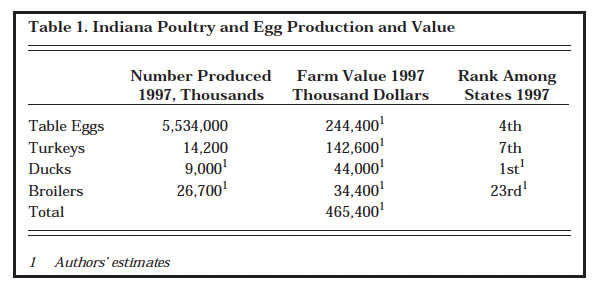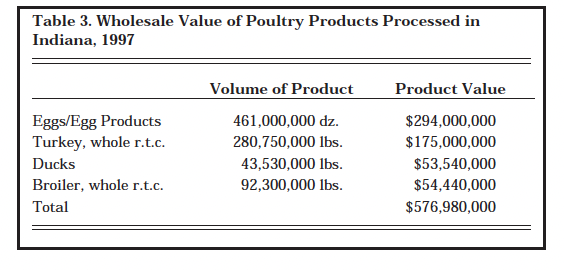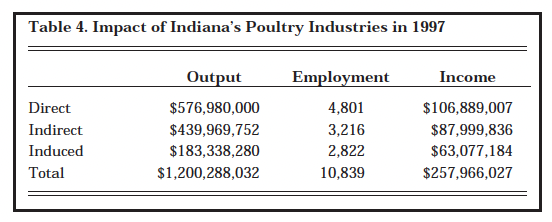Economic Impact of Indianaʼs Poultry Industries
September 12, 1998
PAER-1998-14
Lee F. Schrader, Professor Emeritus and Kevin T. McNamara, Professor
The poultry industries of Indiana, eggs, turkeys, chickens, and ducks, rep resent a significant proportion of the value of the state’s agricultural pro-duction. These industries also make a material contribution to the state’s economy. The objective of this paper is to document the economic contribution of the poultry industries to Indiana’s economy.
Estimation of the economic impact of these industries at state level is limited by the data available. Official data for broilers and ducks are not published for the state
to avoid disclosure of the activities of individual firms. Estimates in this study are based on official data supplemented by data gathered in an informal survey by the senior author. The estimates should not be regarded as exact measures but as approximations that reflect the general magnitude of the contribution.
Poultry Production
Eggs ranked fourth in value among major Indiana agricultural commodities in 1996 after corn, soybeans, and hogs, at 5.8 percent of total farm cash receipts. All poultry and eggs represented 9.9 per-cent of cash receipts of Indiana farms (Indiana Agricultural Statis-tics). Production and farm value of production are presented in Table 1. Farm values are based on standardized prices and do not correspond exactly to cash receipts data that may include the value of some processing services.
Poultry production is concentrated in several areas of the state. The impact of a concentration of poultry production is particularly clear in Dubois, Kosciusko, and Daviess counties, which ranked first, second, and fifth, respectively, in cash farm receipts for 1995.
These industries are major users of locally produced feed ingredients. Rough feed use estimates based on feeding standards are shown in Table 2. Estimates include some poultry feed produced in Indiana for use out-of-state. Local use of corn and soybean meal has the effect of increasing local prices relative to the national averages (increasing local basis).
Indiana’s production of egg type chicks exceeds the needs of the state’s egg producers by a significant amount. In 1997, Indiana hatcheries produced 85.6 million egg type chicks, an estimated 52 million in excess of in-state needs. The value of the chicks shipped out was about
$11.7 million. However, not all the hatching eggs used in the state were produced in Indiana. Approximately 27 million hatching eggs were shipped into the state based on hatching egg use and reported pro-duction of hatching eggs in the state.
Broiler slaughter in 1997 included net in-shipment of about 5.5 million live birds with a value of about $6,100,000. Indiana consumes more chicken than is produced in the state but is a net exporter of eggs, turkey, and duck. Substantially all of the poultry and eggs produced in the state are processed in the state.
Product Value
Estimated wholesale value of products processed in Indiana is shown in Table 3.
Economic Impact
The impact of the poultry industries on Indiana’s economy extends well beyond the value of poultry products. The value of production represents the direct effect. The activity also stimulates indirect and induced effects. Indirect effects represent the spending of other industries that supply products to the poultry and egg processors. Additional activity generated as a result of added income of employees of these sup-porting industries is referred to as an “induced effect.”

Table 1. Indiana Poultry and Egg Production and Value

Table 2. Estimated Feed Use for Poultry Production in Indiana, 1997
Input-output analysis, a modeling technique, is used to assess the degree of interaction among sectors of the economy. IMPLAN ( IMpact Analysis for PLANning) software is used to compute output, income, and employment impacts. Output impacts are the changes in sales or receipts resulting from an initial change in the economy (e.g., increase in poultry and egg processing). Income impacts are changes in household income resulting from the increase in total sales. Employment impacts are jobs added in the economy by firms with increased output or sales. IMPLAN used 1994 Indiana data to derive the appropriate multi-pliers. These multipliers are used to generate estimates of the impact of the 1997 poultry industry activity
(Table 4).

Table 3. Wholesale Value of Poultry Products Processed in Indiana, 1997.

Table 4. Impact of Indiana’s Poultry Industries in 1997
Conclusions
Indiana’s poultry production represented nearly 10 percent of the farm receipts in 1997. The total value of output associated with poultry and egg production and processing in Indiana is estimated to have been 1.2 billion dollars. These activities produced household incomes of 259 million dollars in the state and pro-vided employment for an estimated 10,839 persons. These estimates imply an average income of nearly 24 thousand dollars per person employed.
Broiler production and processing levels have been increased from those of 1997. Thus the value of production for the poultry industries is likely to be slightly higher in 1998.
References
Minnesota IMPLAN Group, Inc. 1997. IMPLAN Professional: Social Accounting & Impact Analysis Software.
Indiana Agricultural Statistics 1996-1997. 1997. Indiana Agricultural Statistics Serv-ice, Purdue University.
